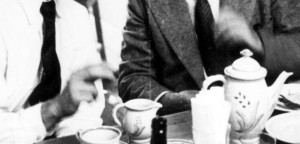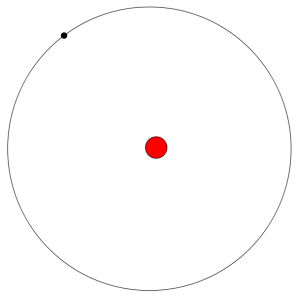(This post is the first in a two-part series. I adapted it from a keynote address I delivered in the summer of 2010 at Goddard College, in Plainfield, Vermont, where I teach in the MFA Writing program. The essay is part of a collection of talks by Goddard writing faculty that have been collected in Alchemy of the Word: Writers Talk About Writing. Part 2 will appear tomorrow.)
 During the final faculty meeting of the residency*, we always discuss ideas for the theme of the following semester’s residency. Last semester someone suggested “The Spirit of the Thing.” The response around the table was instantaneous: That’s it! The vote was swift and unanimous. Then we all laughed. We’d never seen such a response to a possible residency theme. A theme that, we might have noticed if we’d thought about it at all, consisted of two abstractions. If a student had written that phrase, any one of us would have scrawled “vague!” in the margin. I don’t remember now who suggested “The Spirit of the Thing,” but I doubt that she or he would have been able to say what it meant. I doubt that any of us could have said what those two nouns in that combination meant. But they sounded good together, and sometimes that’s enough.
During the final faculty meeting of the residency*, we always discuss ideas for the theme of the following semester’s residency. Last semester someone suggested “The Spirit of the Thing.” The response around the table was instantaneous: That’s it! The vote was swift and unanimous. Then we all laughed. We’d never seen such a response to a possible residency theme. A theme that, we might have noticed if we’d thought about it at all, consisted of two abstractions. If a student had written that phrase, any one of us would have scrawled “vague!” in the margin. I don’t remember now who suggested “The Spirit of the Thing,” but I doubt that she or he would have been able to say what it meant. I doubt that any of us could have said what those two nouns in that combination meant. But they sounded good together, and sometimes that’s enough.
It was for me, anyway. Even as the program director asked if I would be one of the keynote speakers, I knew the topic I wanted to address. Earlier in the week, another faculty member had invoked the Heisenberg uncertainty principle during her own keynote address, and I’d been thinking about it all week—or thinking near it, anyway: its less famous but, to my amateur-historian-of-science way of thinking, more profound corollary.
In early 1927, the German theorist Werner Heisenberg published a paper arguing that you can’t make an observation at the quantum level without disturbing the object you’re observing. (I’m summarizing broadly, both here and elsewhere in this essay.) All information comes to you from your senses, so if you wanted to observe an electron, for example, you would first have to find a way to make it accessible to sight. You would need a photon—a packet of light—to interact with it. That interaction, however, will disturb the electron under observation—the thing. We can observe the thing, but we have to change the thing in order to observe it, and that change leaves us at a loss: We can’t describe the thing completely.
This insight provoked a crisis in physics that, as is often the case with upheavals in science, carried philosophical implications. Since the dawn of the Scientific Revolution three hundred years earlier, investigators of nature had proceeded under the assumption that if they wanted to describe a thing completely, they could do so. Now, suddenly, they knew they couldn’t. The certainty that had sustained our interaction with nature, reality, the universe—whatever you wanted to call it—turned out to be, in retrospect, an illusion. What’s a physicist to do?
 Later that same year, the theorist Niels Bohr answered that question. In a lecture at the Como Conference in September 1927, he articulated a principle that expanded on Heisenberg’s. True, he acknowledged, you can’t describe a thing completely. On the quantum level you can’t determine an electron’s position and velocity simultaneously, for instance, or you can’t invoke light as both particle and wave at the same time. But rather than interpreting the relationship between position and velocity or between particle and wave as contradictory, Bohr suggested, we might more profitably recast them as complementary.
Later that same year, the theorist Niels Bohr answered that question. In a lecture at the Como Conference in September 1927, he articulated a principle that expanded on Heisenberg’s. True, he acknowledged, you can’t describe a thing completely. On the quantum level you can’t determine an electron’s position and velocity simultaneously, for instance, or you can’t invoke light as both particle and wave at the same time. But rather than interpreting the relationship between position and velocity or between particle and wave as contradictory, Bohr suggested, we might more profitably recast them as complementary.
According to the principle of complementarity, both interpretations are correct; neither is complete. Light is a wave when we observe it one way; light is a particle when we observe it another way. The interaction between observer and the thing being observed not only disturbs the thing under observation but defines it.
What’s more, the definition should include not only the influence of the observer—the choice of particle or wave—but the conditions of the experiment. “When you ask, ‘What is light?’” the historian of science Gerald Holton wrote about Bohr’s complementarity, “the answer is: the observer, his various pieces and types of equipment, his experiments, his theories and models of interpretation, and whatever it may be that fills an otherwise empty room when the light bulb is allowed to keep on burning. All this, together, is light.”
In an essay two years later, Bohr illustrated this idea by asking the reader to imagine using a stick to examine an object in a dark room (an illustration I’ll take the liberty of extrapolating from). Where is the dividing line between you and the thing? Is it in the end of the stick as it prods the thing? The shaft of the stick as it bends or doesn’t bend, vibrates or doesn’t vibrate—as it becomes the vessel for the information that is passing from thing to you? Is it where your hand grips the other end of the stick? In the nerves that carry the information from the palm of your hand to your brain? In the neurons and synapses that create biological and chemical reactions that we interpret as information?
 And then there’s the thing. Where is the dividing line between it and its environment? Ever since Newton came up with the law of universal gravitation, physicists have assumed that matter attracts matter regardless of how far apart the two objects are. If the universe in its entirety consisted of two hydrogen atoms 10 billion light-years apart, they would still be gravitationally influencing each other. In principle, if you were defining the thing at the end of your stick, you would have to take into account the gravitational interaction between it and the thing, between the thing and the other objects in the room, between the thing and the walls, between the thing and everything on the other side of those walls: the Moon and the planets and the Sun and all the stars in our galaxy and all the other galaxies.
And then there’s the thing. Where is the dividing line between it and its environment? Ever since Newton came up with the law of universal gravitation, physicists have assumed that matter attracts matter regardless of how far apart the two objects are. If the universe in its entirety consisted of two hydrogen atoms 10 billion light-years apart, they would still be gravitationally influencing each other. In principle, if you were defining the thing at the end of your stick, you would have to take into account the gravitational interaction between it and the thing, between the thing and the other objects in the room, between the thing and the walls, between the thing and everything on the other side of those walls: the Moon and the planets and the Sun and all the stars in our galaxy and all the other galaxies.
And there’s more. There always is. There’s a whole universe out there, and if you don’t set limits, then every consideration of the relationship between you and the thing would quickly deteriorate to the same reductionistic conclusion: The thing is the universe. You have to draw the line somewhere—the line that isolates the system, that serves as its perimeter, that excludes everything in the universe that is not the thing. What you choose to include—what remains inside the perimeter—is then by definition the thing. And in some circumstances, we call that thing a book.
(Tomorrow: Part 2.)
* In a low-residency program, faculty and students are in residence on campus twice a year, at the start of each semester.
• • •
Walking stick: buystarwarscostumes.com; Heisenberg and Bohr: cdsweb.cern.ch; Bohr model of hydrogen: Bohr model Hydrogen.JPG: Renjishino1 (derivative work: Asiela).
The “ding an sich,” Richard, the thing in itself. Who said that? Kant? What did (he) mean by it, aside from the obvious? If you force me to look it up myself, I will.
Yes, Ann, it was Kant, but I didn’t want to go in that direction for this piece. As for what he meant, http://www.saturdayeveningpost.com/wp-content/uploads/satevepost/james_thurber.pdf
Good grief, did you READ that? I loved Kant once but I wouldn’t want to go in that direction either.
Richard, Often one draws a boundary and then asks how the stuff behaves inside, as you state. But sometimes you do something else in science – reduce the problem to something unphysical but at least understandable. It is like the physics joke of two physicists who are puzzled by a cow’s behavior. When they sit down to discuss it, they start out “Let’s assume the cow is spherical.” When we model something in cosmology, instead of drawing a border, we often just “smooth” the Universe outside of what we are studying, rather than ignore it. There is some physics to this, in that Gauss’s Law which pertains to 1/r^2 forces allows us to precisely ignore what is outside of the boundary for reasonably symmetrical systems, which we sure as hell hopes the Universe is. Thanks for the thoughts here!
Thanks, Nick. I think you’ve described the boundary around my sphere of knowledge. As always, I appreciate the insight.
I’ve always been floored at the practical implications of Heisenberg’s principal. You can’t know both position and speed. But what about a total vacuum? There’s nothing there, so you know it exactly, right? No. You get quantum foam, experimentally verified, unpredictably random.
In the Holographic Principal, you can pick any boundary. And the ‘information’ can be found on it’s surface. An infinite number of such boundaries can be considered. So, i guess, the information that is me can be found anywhere except where i am.